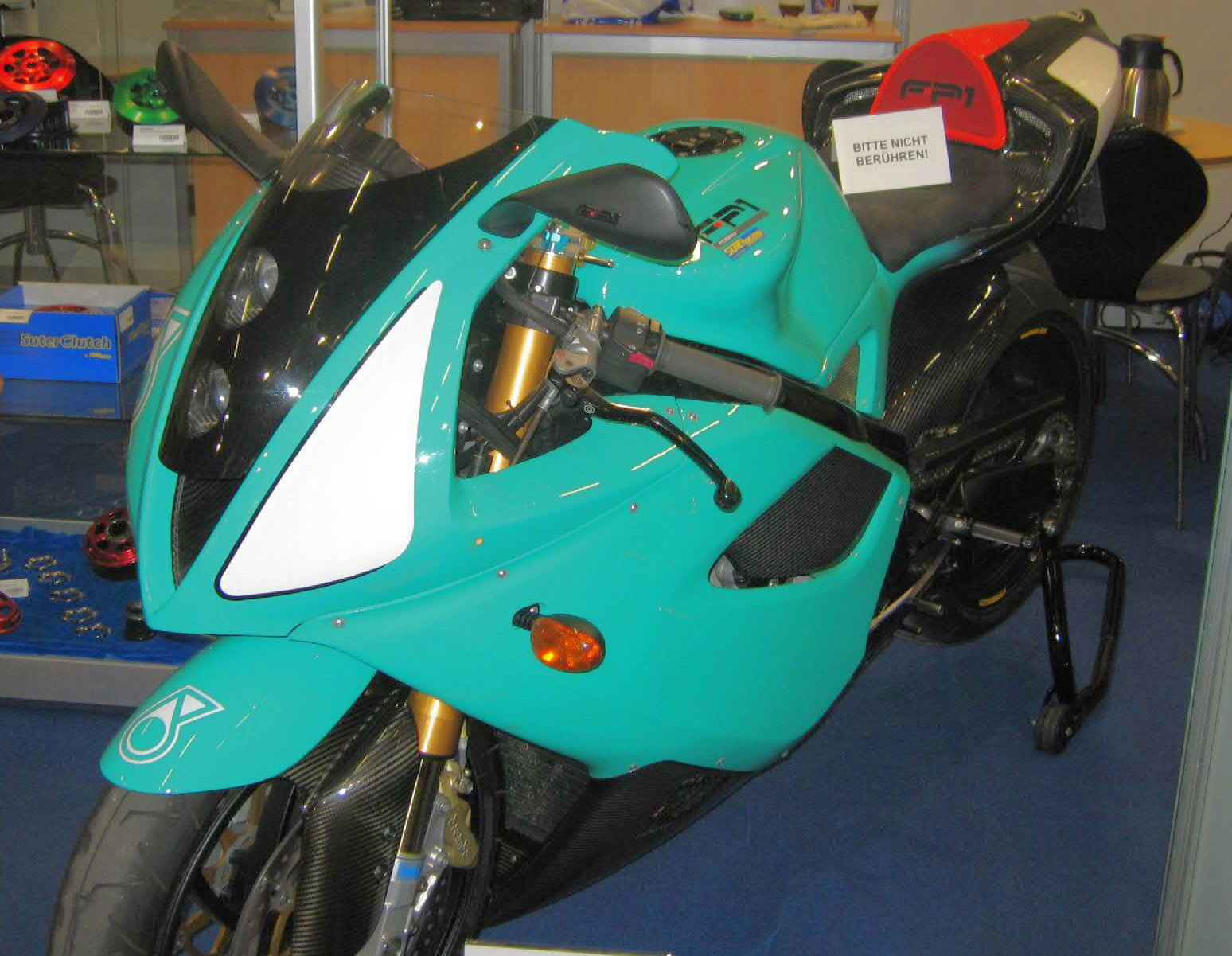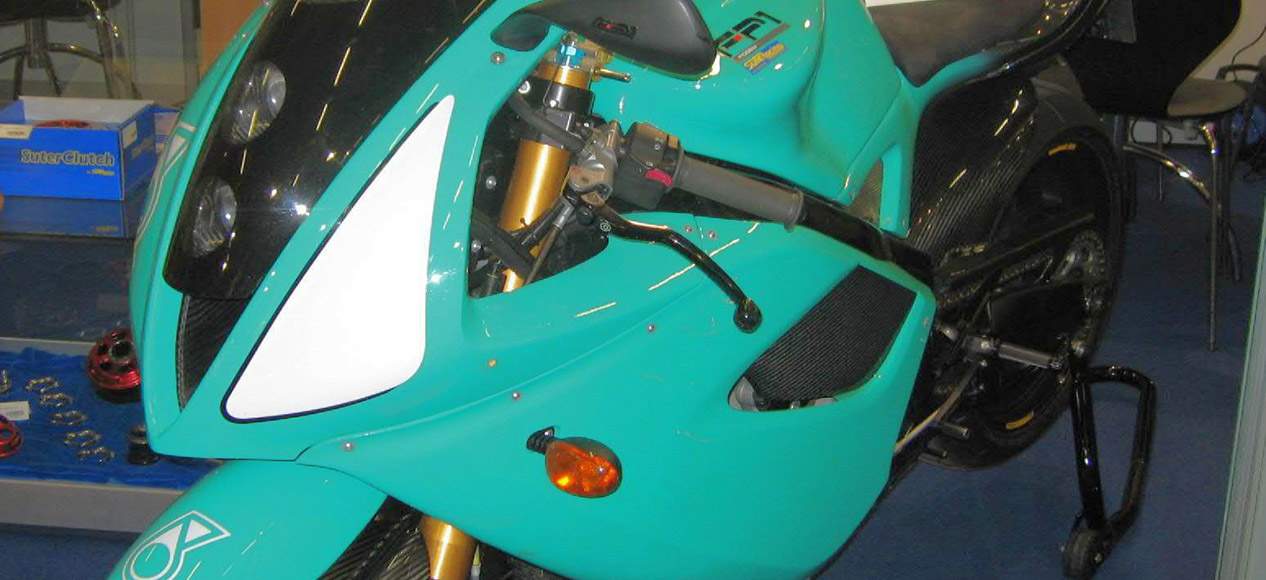A collection of one of the rarest and most mysterious superbikes of all time, the Petronas FP1, is set to go on sale in 2019 – after a British classic car restoration specialist announced that it was preparing a batch of the ill-fated machines at its Hampshire workshops.
The Petronas was born out of the start of the MotoGP racing era and utilised a 989cc three-cylinder engine using technology from the Sauber Petronas Formula One car of the time. Niall Mackenzie tested a prototype, which used a British built Harris chassis, and even paraded the machine at the 2001 Malaysian Grand Prix.
Despite the hype, the Petronas project was quietly shelved – before surprisingly re-emerging as a world superbike project headed up by the recently retired racing legend Carl Fogarty.
Known as the Petronas FP1 (FP1 standing for Foggy Petronas One) the bike was reengineered a capacity of 899cc to meet world superbike regulations, which allowed 1000cc twins to race against 750cc fours and 900cc triples. The rules also demanded that racers were to be based on a homologated production bike, with a run of 150 machines scheduled to be produced in line with the regulations.
The race team had been scheduled to enter world superbikes in 2002, but delays in production led to riders Troy Corser and James Haydon having to sit out the year. An initial run of 75 bikes were built in the UK and homologated in January 2003, allowing the team to finally hit the track that season.
Despite having a massive budget from the Malaysian oil giants, success was hard to find for Petronas. The bike proved to be slow and unreliable, while rule changes increasing the engine capacity for fours to 1000cc reduced the Petronas’ theoretical competitive advantage at a stroke. Corser, a multiple champion and proven race winner, ended the first season 12th in the standings (with a best result of fifth). The following year was to prove Petronas’ best. Helped in no small part by a depleted entry as the factory teams switched their attention to MotoGP, Corser scored a second place in Misano (on his way to ninth in the championship) while Chris Walker also scored a podium at Valencia. The project continued into 2005 and 2006 and, despite the talents of Garry McCoy, Craig Jones and Steve Martin, the machines became increasingly unreliable and struggled to even make the points.
Alongside this, there remained a mystery regarding the run of production machines. An additional 75 bikes were assembled in Malaysia in early 2003, using the facilities of national manufacturer Modenas, and 100 were slated to go on public sale. While a few did find their way into private hands, most were assumed to have been mothballed by the manufacturer – who did not want their great white elephant out in the public domain. A batch of 60 were discovered in the UK in 2010, but all has been quiet until Lanzante, the Hampshire based classic vehicle specialists, announced on social media recently that it was putting a number of bikes into full working order, to be made available with a full spares package.
In true FP1 style, there remain a number of unanswered questions – such as the exact origin of the bikes, how precisely they will be put on the market, and even the exact number of units being commissioned. Despite the underwhelming performance on the race track, and some rather average performance figures for the road bike (which is claimed to make 127bhp at 10,000rpm) the rarity value is likely to see them be in much demand from bike collectors.

There’s also no denying that they are pretty little motorcycles, especially in the iconic ‘Panache Green’ colour scheme that adorned the race bikes, making them an intriguing museum piece for years to come.
A collection of one of the rarest and most mysterious superbikes of all time, the Petronas FP1, is set to go on sale in 2019 – after a British classic car restoration specialist announced that it was preparing a batch of the ill-fated machines at its Hampshire workshops.
The Petronas was born out of the start of the MotoGP racing era and utilised a 989cc three-cylinder engine using technology from the Sauber Petronas Formula One car of the time. Niall Mackenzie tested a prototype, which used a British built Harris chassis, and even paraded the machine at the 2001 Malaysian Grand Prix.
Despite the hype, the Petronas project was quietly shelved – before surprisingly re-emerging as a world superbike project headed up by the recently retired racing legend Carl Fogarty.
Known as the Petronas FP1 (FP1 standing for Foggy Petronas One) the bike was reengineered a capacity of 899cc to meet world superbike regulations, which allowed 1000cc twins to race against 750cc fours and 900cc triples. The rules also demanded that racers were to be based on a homologated production bike, with a run of 150 machines scheduled to be produced in line with the regulations.
The race team had been scheduled to enter world superbikes in 2002, but delays in production led to riders Troy Corser and James Haydon having to sit out the year. An initial run of 75 bikes were built in the UK and homologated in January 2003, allowing the team to finally hit the track that season.
Despite having a massive budget from the Malaysian oil giants, success was hard to find for Petronas. The bike proved to be slow and unreliable, while rule changes increasing the engine capacity for fours to 1000cc reduced the Petronas’ theoretical competitive advantage at a stroke. Corser, a multiple champion and proven race winner, ended the first season 12th in the standings (with a best result of fifth). The following year was to prove Petronas’ best. Helped in no small part by a depleted entry as the factory teams switched their attention to MotoGP, Corser scored a second place in Misano (on his way to ninth in the championship) while Chris Walker also scored a podium at Valencia. The project continued into 2005 and 2006 and, despite the talents of Garry McCoy, Craig Jones and Steve Martin, the machines became increasingly unreliable and struggled to even make the points.
Alongside this, there remained a mystery regarding the run of production machines. An additional 75 bikes were assembled in Malaysia in early 2003, using the facilities of national manufacturer Modenas, and 100 were slated to go on public sale. While a few did find their way into private hands, most were assumed to have been mothballed by the manufacturer – who did not want their great white elephant out in the public domain. A batch of 60 were discovered in the UK in 2010, but all has been quiet until Lanzante, the Hampshire based classic vehicle specialists, announced on social media recently that it was putting a number of bikes into full working order, to be made available with a full spares package.
In true FP1 style, there remain a number of unanswered questions – such as the exact origin of the bikes, how precisely they will be put on the market, and even the exact number of units being commissioned. Despite the underwhelming performance on the race track, and some rather average performance figures for the road bike (which is claimed to make 127bhp at 10,000rpm) the rarity value is likely to see them be in much demand from bike collectors.
There’s also no denying that they are pretty little motorcycles, especially in the iconic ‘Panache Green’ colour scheme that adorned the race bikes, making them an intriguing museum piece for years to come.



